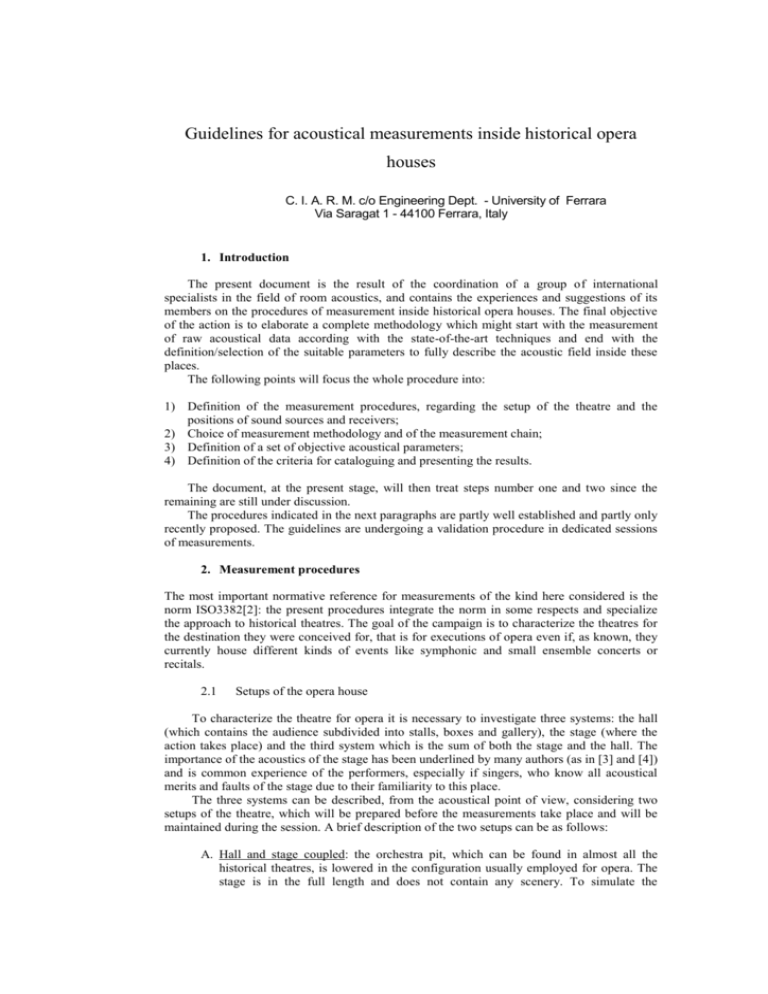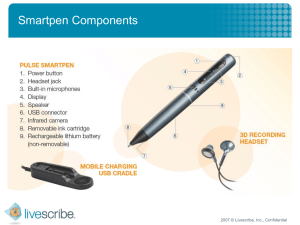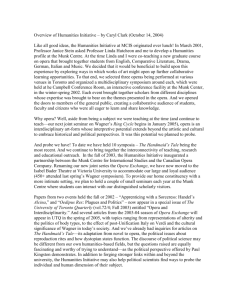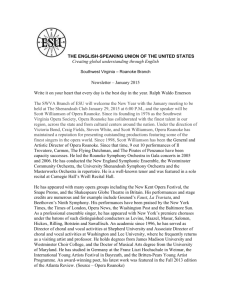Guidelines for acoustical measurements inside historical opera
advertisement

Guidelines for acoustical measurements inside historical opera houses C. I. A. R. M. c/o Engineering Dept. - University of Ferrara Via Saragat 1 - 44100 Ferrara, Italy 1. Introduction The present document is the result of the coordination of a group of international specialists in the field of room acoustics, and contains the experiences and suggestions of its members on the procedures of measurement inside historical opera houses. The final objective of the action is to elaborate a complete methodology which might start with the measurement of raw acoustical data according with the state-of-the-art techniques and end with the definition/selection of the suitable parameters to fully describe the acoustic field inside these places. The following points will focus the whole procedure into: 1) Definition of the measurement procedures, regarding the setup of the theatre and the positions of sound sources and receivers; 2) Choice of measurement methodology and of the measurement chain; 3) Definition of a set of objective acoustical parameters; 4) Definition of the criteria for cataloguing and presenting the results. The document, at the present stage, will then treat steps number one and two since the remaining are still under discussion. The procedures indicated in the next paragraphs are partly well established and partly only recently proposed. The guidelines are undergoing a validation procedure in dedicated sessions of measurements. 2. Measurement procedures The most important normative reference for measurements of the kind here considered is the norm ISO3382[2]: the present procedures integrate the norm in some respects and specialize the approach to historical theatres. The goal of the campaign is to characterize the theatres for the destination they were conceived for, that is for executions of opera even if, as known, they currently house different kinds of events like symphonic and small ensemble concerts or recitals. 2.1 Setups of the opera house To characterize the theatre for opera it is necessary to investigate three systems: the hall (which contains the audience subdivided into stalls, boxes and gallery), the stage (where the action takes place) and the third system which is the sum of both the stage and the hall. The importance of the acoustics of the stage has been underlined by many authors (as in [3] and [4]) and is common experience of the performers, especially if singers, who know all acoustical merits and faults of the stage due to their familiarity to this place. The three systems can be described, from the acoustical point of view, considering two setups of the theatre, which will be prepared before the measurements take place and will be maintained during the session. A brief description of the two setups can be as follows: A. Hall and stage coupled: the orchestra pit, which can be found in almost all the historical theatres, is lowered in the configuration usually employed for opera. The stage is in the full length and does not contain any scenery. To simulate the absorption of the scenery in a standardized way 500 m2 of heavy curtains will be hung from the ceiling in the back of the stage. If some fitting were present and the above conditions could not be met, it will be care of the experimenter to give a detailed description of the scenery in the report of the results. B. Hall and stage decoupled: is like setup A as concerns the orchestra pit and stage. In this case the fire-curtain and the curtain are lowered to make the hall and the stage acoustically independent. The two setups are pictured respectively in Fig. 1 and 2 where also the positions of sound sources and receivers are indicated as explained in the following. The measurement conditions will be as similar as possible to those during performances as regards the curtains in the hall, the furniture of boxes, the doors and the air conditioning apparatus. Whenever possible the orchestra pit will be equipped with chairs and music stands. The whole measurement session will take place without the audience. Nevertheless it will be verified the possibility to take a reduced set of measures with the audience present. In this respect four points in the stalls and four in the boxes for one position of the sound source (which will be positioned according to the demands of performers) can be considered sufficient. 2.2 Positions of sound sources and of receivers The sound sources and the receivers are positioned in order to characterize the acoustical environment for the audience, who formulates the judgment upon it, and for the performers, who might suffer the acoustical conditions in some circumstances (i.e. [5],[6]). In the zone of the theatre occupied by the performers (that is orchestra pit and stage) both sources and receivers will be positioned whereas in the hall, where only the audience is supposed the be accommodated, only receivers will be placed. Fig. 3 shows the plan with the positions of sources (indicated with small circles) and of receivers (indicated with small squares). The numbering of sources reports the letter relative to the setup and a progressive number, while the numbering of receivers is simply progressive. In the pictures also an indication of the distance from reference points in the orchestra pit and on the stage is shown. The sound sources are omnidirectional (unless otherwise stated) and each position of a sound source which is marked in the plan correspond to a complete set of measures of the grid of receivers. All the positions of sound sources, except the one indicated with A2, lie along a line which is parallel to the longitudinal axis of symmetry of the theatre at a distance of 1m from it. The offaxis positioning of the sound sources avoids that spurious effects due to the symmetry of the hall alter the data. The sound sources are placed as follows: A. Hall and stage coupled : two positions in the orchestra pit, one named 1° violin (A1) and another in the covered part of the pit in the usual position of double-basses or trombones (A2); two positions on the stage, one at two meter from the line of the fire-curtain (A3) and the second three meters behind (A4); one position for a directional source (A5). A. Hall and stage decoupled: one position in the orchestra pit, 1° violin (B1) one position on the stage at five meters distance from the fire-curtain (B2). The grid of receivers consists of 21 points: 9 in the stalls, 3 in the first order boxes, 3 in the third order boxes, 3 in the gallery, 2 in the orchestra pit and 1 on the stage. If the time available to make the measurements limits the possibility of going trough the complete grid, it is possible to use a reduced grid of receivers, made up of 12 points. This simplified grid can be easily obtained by considering only the even (or odd) positions of receivers in the plan. The receivers numbered 19, 20 e 21 are to be taken in any case. Due to the supposed acoustical symmetry of the hall the receives are positioned only on one half of the hall. The verification of the symmetry can be left to the occurrence of visual discrepancies between the two halves. The position 19, corresponding to the conductor, and the position 20, corresponding to the singer, lie on the symmetry axis while position 21 (deep instruments) is at 1.5 m from the lateral wall and at 1 m from the back wall of the orchestra pit. The measurement procedure when the sound source is in the markedly asymmetric position A2 is divided into three steps: 1. the sound source is placed in A2 and measures are taken for the receivers indicated from 1 to 21; the positions of the sound source and that of receiver 21 are swapped; measures are taken for the receivers from 1 to 18. 2. 3. In the setup B the receiver 21 is not included. Moreover in this setup the measures in the positions from 1 to 19 are taken when the source is in B1, while when the source is in B2 only the measure in the position 20 is taken 4. Measurement method 4.1 Measurement principles The primary data for the acoustical evaluations of the opera houses and for the application of the technologies of virtual acoustics are the impulse responses in the different positions inside the hall. To obtain impulse responses of good quality in terms of signal to noise ratio a widely employed method is the joint use of pseudo-random sequences as test signals (i.e. maximum length sequences) and of correlated time averages (cfr.[7]). This approach is here proposed as the basic method for measurements inside historical opera houses. An alternative principle, which is currently being tested and compared with the former, involves the use of a signal called "time stretched pulse" and the respective deconvolution of this signal from the system's response. This method, as suggested by its current users [8], proves more robust against the micro-variations of the thermo-igrometric conditions of the hall during the measurement since it is based on a shorter time emission of the test signal. 4.2 Recording the opera house responses: monaural, binaural and B-format measurements To record the test signal there exist different methods, each involving favorable aspects and unfavorable ones. In the present context a balance has to be struck between the needs of having a simple methodology and of taking raw data as accurate as possible. With this in mind, the experimenter can decide to follow three separate methodologies in making the surveys, namely monaural, binaural and B-format recordings. Each of them permits to retrieve the basic acoustical information, but the raw data provided in each case are of different kind. The choice of the methodology by the experimenter strongly depends upon the time required for measures and post-processing, and on the equipment available for the surveys. 4.2.1 Monaural recordings The fundamental methodology of recording the hall responses employs a monaural probe consisting of an omnidirectional microphone. Monaural measurements of this kind allow the straightforward calculation of a set of useful objective parameters and can thus be regarded as the basic choice for a general-purpose investigation. To gain insight into the spatial characteristics of the sound field a combination of monaural measurements with microphones of different directivities is needed (i.e. omnidirectional versus figure-of-eight with null axis pointing to the source). This latter choice can be regarded as an enhancement of the monaural recording methodology, mainly linked to the set of parameters to evaluate. 4.2.2 Binaural recordings For a complete evaluation of the spatial attributes of the acoustic field as perceived by the listeners it is necessary to have the binaural impulse responses which contain the dissimilarity perceived at the positions relative to the ears of an antropometric sound probe, typically a dummy head equipped with two microphones (cfr.[9]). But, while there is generally a good agreement on the measurement method of monaural impulse responses, the procedure of measuring with dummy heads is far less standardized and strongly depends on the sound transmission characteristics of the probe used. In other words, when this choice is made, there is the need of achieving a set of primary data as independent as possible from the binaural sound probe used while making the recordings. This problem has to be faced in order to make measurements comparable between different teams. To reach this task there seem to be two possible ways: A. Standardizing the binaural sound probe; B. Standardizing a signal post-processing procedure to make the measured data independent of the probe. Option A implies considerable economic effort by experimenters and poses the further question of which probe should be taken as reference. In this respect one solution can be taking the simplest binaural probe, like a spherical microphone of exactly predictable diffraction characteristics. Another solution can be taking the Kemar head as model, since almost all acoustical data for this head are measured and available (i.e. [10]). Option B requires a dedicated post-processing of the data, which has high costs in terms of time. If this is the choice, a suitable post-processing procedure can be arranged into five steps described below. The core of the process is a virtual source imaging method which is based on the use of two closely spaced loudspeakers (about 10° as seen from the listener) and on a form of regularization of inverse filters, which has proved to be simple and very effective. The procedure can be referred to globally as “stereo dipole”(cfr.[11],[12]). According to this approach the steps to make the binaural measures independent of the probe can be traced as follows: 1. 2. 3. 4. 5. Measurement of impulse responses in the opera house with the available binaural probe; Calculation (in an anechoic chamber) of acoustical transmission characteristics of the binaural probe by means of two closely spaced frontal loudspeakers in the “stereo dipole” configuration; Calculation of the inverse filters related to the binaural probe according to the regularization suggested in [13]; Filtering out the effect of the particular probe used and cancellation of cross-talk, thus obtaining acoustical data which can be considered almost universal; Filtering the data obtained at point 4 with the suitable transmission filters of a Kemar dummy head. These filters have to correspond to angular positions of the two loudspeakers employed in the “stereo dipole” configuration. The data obtained during the procedure at points 4 and 5 can be used respectively to calculate the monaural and the binaural parameters for objective qualification of the acoustical space. By means of this procedure the comparison of the measurements between different teams is made possible. In addition, the "stereo dipole" procedure is well suited for auralization, which is one of the scopes of the measurements [14]. 4.2.3 B-format recordings The third choice of recording is the use a sound probe called "soundfield" microphone (cfr.[15],[16]) according to the so-called B-format standard (cfr.[17],[18]). The soundfield microphone measures four monaural signals, the first (called W) being omnidirectional (sound pressure) and the other three (called X,Y,Z) corresponding to figure-of-eight directivities with major sensitivities directed along the respective Cartesian axes. This approach is completely different from point 4.2.2 and permits a close reconstruction of the sound field without the need of antropometric probes. Within this scheme the omnidirectional signal can be employed to evaluate monaural criteria and the spatial characteristics of the sound field are enclosed in the three directional signals. Moreover this standard offers an easy implementation for the scopes of auralization. 5. 5.1 Typology of measurement equipment Sound sources The sound sources for acoustic measurements shall meet strict requirements of omnidirectionality, particularly in the higher frequency range. In particular the limits in the Tab I of [2] must be largely satisfied. Together with the directional characteristics, a critical point of customary sound dodecaedric sources widely used for room acoustics measurements is their frequency range. For auralization purposes it is necessary to guarantee an almost flat spectrum of the sound source from the octave band centered at 50 to that at 8000 Hz, which seems actually to be rather critical to be obtained with commercial sources. As far as the directional source to place in position A5 is concerned, its emission has to resemble the directivity of the singer (cfr. [19]). But, since no standard sound sources are available for emulating the singing voice, the directivity pattern of the employed directional source shall be included in the documentation of the measures. 5.2 Sound probes The choice of the measurement method has a counterpart in the use of a suitable sound probe. For basic monaural measurements it is sufficient to use an omnidirectional microphone (typically ½ inch) while enhanced monaural spatial measurements require a figure-of-eight microphone For standardized binaural measurements it is suggested to adopt either a spherical microphone which has exactly predictable acoustic transmission characteristics or a Kemar head whose acoustical data are fully available. The binaural measurements can anyway be taken with any different dummy head provided that the procedure of post-processing sketched above is implemented. At last special probe is required if the experimenter will record the responses in the Bformat standard. This probe is a four-channel sound field microphone. 5.3 Acquisition and elaboration devices The device employed for recording cannot be analogue: PC sound cards, DAT or HD recording systems are suitable digital solutions. In the last two cases the retrieval of data for elaboration is made off-line. The quantisation of the acquisition system is 16 bits and the sampling frequency is 44.1 kHz. In any case the minimum S/N ratio of the acquisition system is 75 decibels. The quality of primary data is ameliorated with the choice of an appropriate pseudo-random sequence length, which is set for an expected reverberation time of two seconds for the hall (upper limit) and four seconds for the stagehouse. 5.4 Calibration of the measurement chain It is necessary to study the measurement chain in detail in order to guarantee a good repeatability of the surveys. The results also depend on the implementation of the descriptors but the approach in [2] ensures a sufficient compatibility between different strategies. In fact the global uncertainties deriving from different implementations of the acoustical descriptors all satisfying the cited norm are kept within the subjective threshold of variation of acoustical parameters [20]. As far as the calibration is concerned, the minimal requirement is the amplitude calibration of transducers by a pistonphone. 6. Further investigations and concluding remarks An interesting integration to the preceding guidelines is possible if the opera house is equipped with an orchestra shell. This acoustical device, which can actually be found only in few theatres, should be indispensable for the performances of symphonic music. Should the orchestra shell being present, a set of primary data will be taken with the shell mounted as during the executions of symphonic music. The distribution of sources and receivers is, in this case, similar to the setup A, with the following differences: the source A1-A4 keep their position in plan as in Fig. 1 but are on the stage since the orchestra pit disappears during symphonic concerts; The receivers 19,20 and 21 are on the stage for the same reason. The above described procedures and methodologies will provide the scientific tools to give consistence to the safeguard and protection of the acoustical heritage peculiar of the historical opera houses. It is desirable that in the future guidelines of the same kind for acoustical measures inside places of monumental importance (like churches, ancient theatres etc.) will be formulated. 7. References [1] C.N.R., Progetto Finalizzato Beni Culturali, 1997, Roma. [2] ISO/DIS 3382 - Acoustics: measurement of the reverberation time with reference to other acoustical parameters, 1997, Geneva. [3] M. Barron, "Auditorium acoustics and architectural design", E & FN Spon, 1993, London. [4] L.Cremer, H.A. Mueller, "Principles and applications of room acoustics", Applied Science Publishers, 1982, London. [5] J. Meyer, "Sound fields in orchestra pits", Proc. ICA-ASA '98, Seattle (WA), 20-26 June, p. 337. [6] C.N. Blair, "Listening in the pit", Proc. ICA-ASA '98, Seattle (WA), 20-26 June, p. 339. [7] D. Rife, J. Vanderkooy, "Transfer function measurement with maximal - length sequences", J. Audio Eng. Soc. 37, 1989, pp. 419 - 444. [8] T. Hidaka, personal communication. [9] Y. Ando, "Architectural acoustics: blending sound sources, sound fields, and listeners", Springer Verlag, 1998, New York. [10] B. Gardner, K. Martin, "HRTF measurements of a Kemar dummy-head microphone", Tech. Rep. 280, 1994, MIT Media Lab. Of Perceptual Computing [11] O. Kirkeby, P.A. Nelson, H. Hamada, " The stereo dipole - a virtual Source Imaging System using two closely spaced loudspeakers ", J. Audio Eng. Soc., Vol. 46, 5, 1998 May. [12] Web site: www.isvr.soton.ac.uk/FDAG/vap/pages/sd.htm [13] O. Kirkeby, P.A. Nelson, H. Hamada, “Digital filter design for virtual source imaging systems”, Pre-prints of the 104th AES Convention, Amsterdam, 15-20 May, 1998. [14] A. Farina, P. Galaverna, M. Giabbani, “Il processo di auralizzazione: metodologia ed esemplificazione”, Atti del Convegno “L’acustica dei Teatri Storici: un Bene Culturale”, Ferrara, Ridotto del Teatro Comunale, 4 Nov. 1998. [15] K. Farrar, "Soundfield microphone: part 1 & 2", Wireless World, Ott. & Nov.1979, pp. 99 - 103. [16] Web site: www.proaudio.co.uk/sndfield/index.htm [17] P.B. Fellgett, "Ambisonic reproduction of directionality in surround sound systems", Nature, 252, 1974, pp. 534 - 538. [18] M. Gerzon, "Recording concert hall acoustics for posterity", J. Audio Eng. Soc., 23, Num. 7,1975, pp. 569 - 570. [19] H. Marshall and J. Meyer, "The directivity and auditory impressions of singers", Acustica, 58, pp. 130 - 140. [20] M. Vorlaender, H Bietz et al., "Uncertainties of measurements in room acoustics", Acustica, 81, 1995, pp. 344 - 355. curtains 18 15 12 9 8 7 6 5 4 3 2 1 19 21 Fig. 1 - Section of the opera house in the setup A with hall and stage communicating. The sound sources are represented with a small circle and indicated with A followed by progressive number. Th receivers are represented by small squares and a progressive number. Refer to text for the explanation curtains fire curtain down 18 15 12 9 8 7 6 5 4 3 2 1 19 Fig. 2 – Section of the opera house in the setup B with hall and stage decoupled by the firecurtain. The numbering follows criteria of Fig.1. Fig. 3 - Plan of the opera house with the positioning of sound sources for each setup and with the complete grid of receivers. The grid in the hall, though maintaining the indicated form, has to be adapted to the conformation of the stalls (number or rows) and to that of the boxes (number of boxes for each order).








